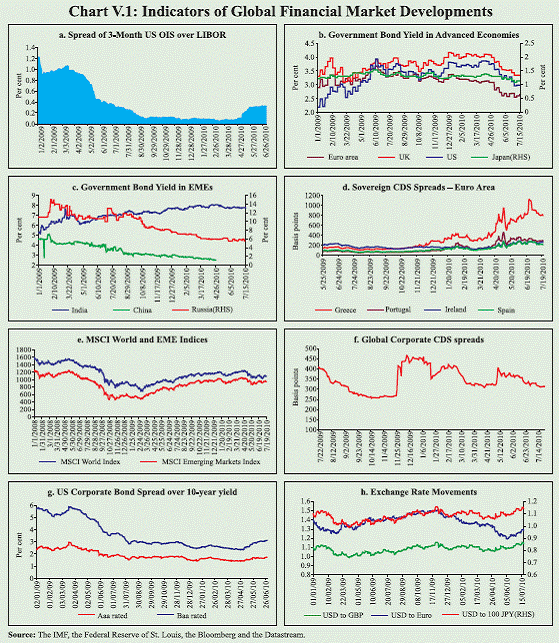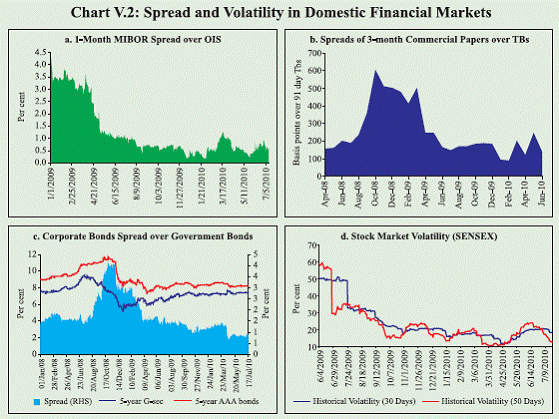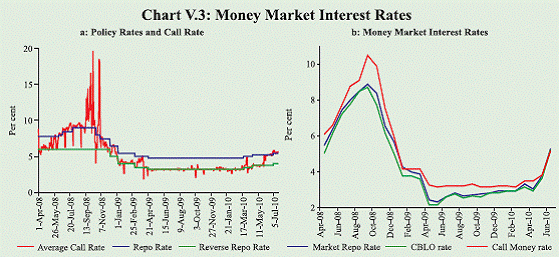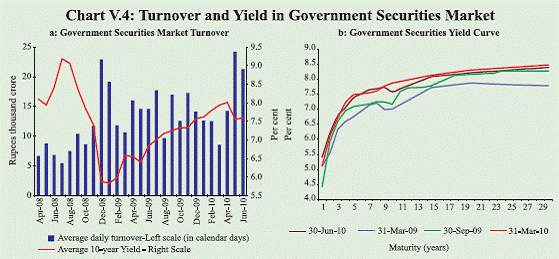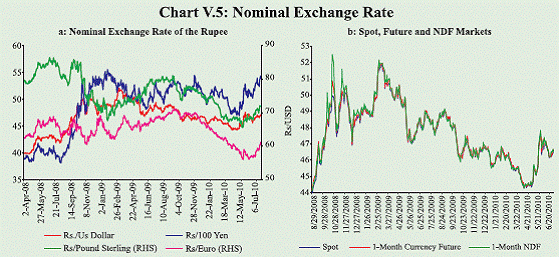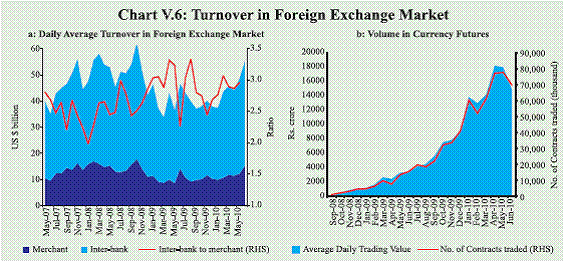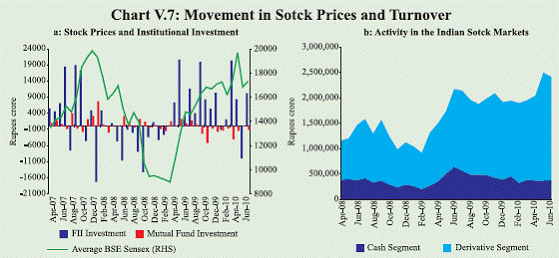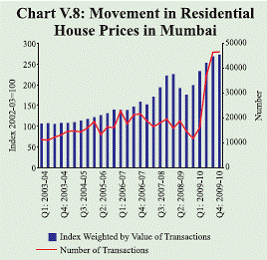 IST,
IST,
V. Financial Markets
Risks to the global financial system increased in Q2 of 2010 in the wake of market concerns about fiscal sustainability in the Euro area and possible spillover to other parts of the world. Domestic financial markets functioned normally during Q1 of 2010-11 though there was some spillover from global volatility. While call money rates edged up due to tight liquidity conditions created by higher revenue inflows to the government, medium to longterm bond yields moderated because of expectations of lower fiscal deficit. Exchange rate of the Indian rupee exhibited some depreciation and equity prices remained mostly subdued, reflecting the impact of the global market trends and FII flows. Housing prices exhibited moderate growth in Q4 of 2009-10. V.1 The global financial markets witnessed greater volatility, drop in risk appetite and flight to safety during Q2 of 2010, reflecting rising fiscal sustainability concerns, weaker outlook for recovery than anticipated earlier and waning investor confidence. Domestic markets, particularly equity, exhibited spillover of global market volatility, notwithstanding the firmer domestic recovery in growth. Domestic fiscal concerns, which had impacted the government bond market in 2009-10 and kept pressure on the medium to long-term yield, remained contained in Q1 of 2010-11 because of the expectation of lower fiscal deficit resulting from larger realisations through 3G/BWA spectrum auctions. Sudden tightening of liquidity in the system in June 2010 exerted pressure on short-term interest rates, though the medium to longterm bond yields declined on receding domestic fiscal risks. International Financial Markets V.2 Although global financial market conditions had improved during 2009 in terms of reduced risk spreads and higher market activity, risks resurfaced towards the end of 2009 and intensified during the first half of 2010. A series of events, starting from debt default of Dubai World, the Greek sovereign debt crisis, spreading of contagion to Spain and other euro area countries and weakening of market confidence reflecting unresolved deeprooted problems in the financial systems, contributed to the significant volatility in the global financial markets. V.3 During Q2 of 2010, global financial markets turned highly volatile as fiscal problems of the euro area and other advanced economies and the risk of anaemic global growth, together led to significant deterioration in investor confidence. Deteriorating fiscal position across euro area continued to cause jitters in financial markets, despite transient stability instilled by the announcement of a significant European rescue package. These developments forced investors to scale down their risk exposures. V.4 The perception that unsustainable public debt of the advanced economies would weigh heavily on the global growth outlook, continues to unsettle equity markets. The signs of growing stress and the fragility of the global financial system were evident in the rising Libor-OIS spreads (Chart V.1a). Specific events, such as growing geopolitical risk in the Korean peninsula, the second sovereign downgrade of Spain by the rating agencies, and difficulties faced by the Spanish savings banks, also weakened the market confidence. V.5 Investors, cautious about the rising and potential risks in the global financial system, reduced their exposure to risky assets. Consequently, there was flight to safe haven assets. This led to a significant fall in sovereign bond yields (Chart V.1b and c). At the same time, investors’ risk perception towards countries inflicted with fiscal problems remained high (Chart V.1d). In both the advanced and emerging market economies (EMEs) stock prices fell significantly and remained volatile (Chart V.1e). Corporate credit spreads, which had remained broadly stable after the Dubai World default, again widened (Charts V.1f and g). The fiscal problems and uncertainty about the growth outlook for the euro area also led to high volatility in currency markets with sharp depreciation of the Euro against other major currencies, though with some recovery in July 2010 (Chart V.1h). While the Euro depreciated against the US dollar, the EME currencies like Russian ruble, Turkish lira, Indian rupee, South Korean won, Argentine peso and Mexican peso came under depreciation pressure due to volatile capital flows and the general safe haven flight to the US dollar (Table V.1). V.6 Increased volatility in international markets was rapidly transmitted to India and other EMEs through volatile capital flows during Q2 of 2010. Reflecting the impact of global market uncertainty, capital inflows to India moderated, led by portfolio flows. This, in turn, led to depreciation of the rupee and moderation in stock prices. Domestic Financial Markets V.7 The concerns in domestic financial markets shifted from the large fiscal deficit and rising inflation in 2009-10 to escalated uncertainties in the global markets and the associated risks to global recovery in Q1 of 2010-11. Nevertheless, several segments of financial markets witnessed further recovery in trading volumes in Q1 of 2010-11, although marked by some increase in price volatility (Table V.2 and Chart V.2). Except for some increase in spread/volatility in certain segments, overall financial market conditions remained stable. Money Market V.8 Liquidity conditions in the interbank market tightened significantly in June 2010, reflecting temporary withdrawal of liquidity from the banking system due to sharp increase in the Government’s one-off collections through 3G/BWA spectrum auction (about Rs.1,31,000 crore) besides the first installment of advance tax payments. Thus, call rate that had mostly remained around the lower bound of the informal LAF corridor up to May 2010, increased subsequently and hovered around the upper bound of the informal LAF corridor (Chart V.3). Responding to this liquidity tightening, the Reserve Bank’s LAF window turned from reverse repo to repo mode. In order to address the liquidity pressures, additional liquidity support was provided to scheduled commercial banks under the LAF to the extent of 0.5 per cent of their net demand and time liabilities (NDTL). The Reserve Bank also conducted second LAF on a daily basis. These measures helped overcome liquidity stress in money markets and contain volatility in call rates. V.9 Transaction volumes in the collateralised borrowing and lending obligation (CBLO) and market repo segments continued to remain high during Q1 of 2010-11 (Table V.3). As in the previous year, banks were the major borrowers in the collateralised segment and mutual funds (MFs) were the major lenders. The collateralised segment of the money market accounted for around 87 per cent of the total volume during Q1 of 2010-11.
V.10 The average certificates of deposit (CD) issuance was placed around Rs.20,600 crore during this financial year (till July 2, 2010) so far, as compared with the average issuance of around Rs.16,700 crore during 2009-10. The volume in commercial paper (CP) market picked up, as corporates increasingly took recourse to CPs for financing their working capital requirements, which is evident from a significant rise in the share of ‘manufacturing companies’ in the outstanding amount of CPs (Table V.4). The tightening of liquidity in money markets led to some upward pressure on interest rates.
Government Securities Market V.11 The Reserve Bank continued with the policy of front-loading of market borrowings during the first half of 2010-11. Accordingly, the Government would complete a major part (about 63 per cent) of the gross market borrowing programme for 2010-11 in the first half of the year so as to limit any crowding-out concerns in the latter half of the year when the private credit demand is normally strong (Table V.5). Due to outflow of liquidity from the banking system on account of 3G/BWA auctions and rise in policy rates, there was an upward movement in the primary market yields of Treasury Bills except for 364-day T-bills which showed a slight moderation initially (Table V.6). The tightening liquidity conditions were partially addressed by scaling down the issuance of Treasury Bills in June 2010 from the planned Rs. 37,000 crore to Rs. 15,000 crore. Further, the second quarter auction calendar for T-Bills has planned for a reduction in net issuance by Rs.24,000 crore. The Government also bought back dated securities to the tune of Rs. 9,614 crore up to July 20, 2010. The notified amount of dated securities for July 2, 2010 auction was lowered from the planned amount of Rs.13,000 crore to Rs.10,000 crore. Cash management bills of 28 and 35 days maturity were also issued in May 2010.
V.12 During Q1 of 2010-11, though short-term yields remained low till end- May due to surplus liquidity conditions, they hardened thereafter, reflecting the tightness in liquidity arising out of 3G/BWA auctions as well as quarterly advance tax payments. The yield at the longer end eased, presumably on expectations of improved fiscal position of the government because of higher than anticipated 3G/BWA auction revenues (Chart V.4). As fiscal deficit concerns for 2010-11 receded, the volume in government securities market improved in Q1 of 2010-11. Credit Market V.13 The spreads on corporate bonds over the government bond yield declined in Q1 of 2010-11 over the levels in Q4 of 2009-10, indicating further reduction in risk for corporates due to improved growth outlook (Chart V.2c). V.14 Bank deposit rates have started moving upward, reflecting not only the competition for attracting deposits but also a change in the interest rate environment reflected in gradually rising policy rates (Table V.7). During Q1 of 2010-11, a few banks raised their deposits rates in the range of 75-100 basis points. On the lending side, the benchmark prime lending rates (BPLRs) of SCBs have remained unchanged since July 2009. The switch over to the base rate system from July 1, 2010 is expected to bring about greater transparency in lending rates. The base rates announced by major public sector banks so far are in the narrow range of 7.25 per cent to 8.0 per cent.
Foreign Exchange Market V.15 The Indian rupee exhibited greater two-way movement against the US dollar during Q1 of 2009-10. The rupee strengthened against the US dollar in April 2010 on the back of capital inflows and positive growth outlook. Subsequently, with the signs of the euro area debt crisis spreading further and the US dollar strengthening against most currencies, and withdrawal of funds by the FIIs, the rupee came under depreciation pressure (Chart V.5a). The exchange rates in the non-deliverable forward market (NDF), the currency future market and the spot market have exhibited similar pattern (Chart V.5b). V.16 Increased volatility in the foreign exchange market resulted alongside increase in turnover in the spot, forward and futures markets (Chart V.6a and b). The rupee-dollar futures continued to dominate the currency futures segments in the exchanges, accounting for about 90 per cent of the total notional values. The higher trading volumes, particularly in the futures market, have coincided with the increased volatility in the spot exchange rate. Equity and Housing Markets V.17 The sustained growth in equity prices that was witnessed in 2009-10, exhibited some correction in Q1 of 2010-11, mainly due to transmission of shocks from global markets (Table V.8), though there has been some recovery in July 2010. V.18 The activity in the primary segment of the domestic capital market displayed signs of revival in Q1 of 2010-11. Resources raised through public issues increased considerably (Table V.9). The resource mobilisation by mutual funds was, however, lower due to tight liquidity conditions and subdued stock markets. During 2009-10, mobilisation of resources by corporates through private placement (Rs.3,42,445 crore) was higher by 67.8 per cent. V.19 Stock prices remained subdued during most part of Q1 of 2010-11 due to concerns regarding adverse global developments (Chart V.7a). While FII investments remained volatile, mutual funds turned net sellers due to increased market uncertainties. With increasing uncertainties and corrections in domestic stock prices, derivatives segment exhibited significant expansion in volumes (Chart V.7b).
V.20 A sustained and rapid rise in housing prices over successive quarters remains an area of concern from the standpoint of their possible spillover to demand pressures and the general price level as well as financial stability (Table V.10 and Chart V.8). During Q4 of 2009-10, however, housing prices displayed subdued momentum in several cities, which could be attributed to concerns of high valuations and the volatile stock market.
V.21 Despite increasing global market uncertainties emanating from the euro area fiscal sustainability concerns, domestic markets functioned normally, though with higher volatility in some segments. Domestic equity prices moderated, though with some recovery in the recent period. The exchange rate showed greater twoway movement partly reflecting rising pressure on the euro and volatility in FII flows. Domestic money markets faced liquidity pressures, leading to hardening of short-term money market rates. Responding to these developments, the Reserve Bank initiated temporary liquidity facilities that helped contain inter-bank call rates around the ceiling of the LAF corridor. Medium to long-term yields, however, moderated on expectations of lower fiscal deficit of the Government and the general safe haven appeal of government bonds globally. The market activities in various segments improved and the primary segment of the domestic capital market exhibited larger mobilisation of resources.
|
|||||||||||||||||||||||||||||||||||||||||||||||||||||||||||||||||||||||||||||||||||||||||||||||||||||||||||||||||||||||||||||||||||||||||||||||||||||||||||||||||||||||||||||||||||||||||||||||||||||||||||||||||||||||||||||||||||||||||||||||||||||||||||||||||||||||||||||||||||||||||||||||||||||||||||||||||||||||||||||||||||||||||||||||||||||||||||||||||||||||||||||||||||||||||||||||||||||||||||||||||||||||||||||||||||||||||||||||||||||||||||||||||||||||||||||||||||||||||||||||||||||||||||||||||||||||||||||||||||||||||||||||||||||||||||||||||||||||||||||||||||||||||||||||||||||||||||||||||||||||||||||||||||||||||||||||||||||||||||||||||||||||||||||||||||||||||||||||||||||||||||||||||||||||||||||||||||||||||||||||||||||||||||||||||||||||||||||||||||||||||||||||||||||||||||||||||||||||||||||||||||||||||||||||||||||||||||||||||||||||||||||||||||||||||||||||||||||||||||||||||||||||||||||||||||||||||||||||||||||||||||||||||||||||||||||||||||||||||||||||||||||||||||||||||||||||||||||||||||||||
पेज अंतिम अपडेट तारीख:






